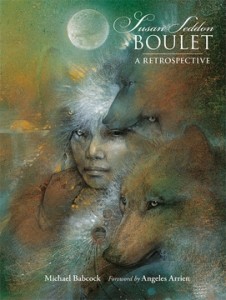 Susan Seddon Boulet’s figures are out of our dreams, those that flee from us upon awakening, those which are dispersed like dew at dawn, those which fall apart between our fingers like dust-roses. — Anais Nin
Susan Seddon Boulet’s figures are out of our dreams, those that flee from us upon awakening, those which are dispersed like dew at dawn, those which fall apart between our fingers like dust-roses. — Anais Nin
I first encountered this artist some years ago when I picked up the American edition of Terri Windling’s The Wood Wife. Now there are some who prefer the more English tone of the Brian Froud artwork on the British cover, but I believe that the Boulet artwork captures the feel of her text better than the Froud does. It captures the dualistic nature, both harshly unacceptable to life and life bearing to an unbelievable degree, of the desert Southwest USA where the novel’s mostly set. (Some of the locales in this novel will be incorporated with the permission of Windling into Medicine Road, the novel by Charles de Lint set here also. Having read that novel, it also felt as if Boulet had in part inspired it.) Which, in a slightly circuitous fashion, brings me to the matter of Susan Seddon Boulet — A Retrospective, a large, expensive, and I must say, stunning book from Pomegranate Press, purveyors of more posters, post cards, bookmarks, and other product using the images of Susan Seddon Boulet that one cares to really think about.
Who was this remarkable artist? Susan Seddon Boulet, a San Francisco Bay Area artist, died at her home in Oakland on April 28,1997 at the far too young age of only fifty-six. As her official Web site notes, ‘She left behind many mourners including her son Eric, brothers Patrick and Ernani and her second mother Naide.’ (Deaths like this piss me off. Angela Carter, another remarkable, also left this mortal coil far too quickly. And Johnny Cunningham died fat too young. The Morrigan has been far too busy.)
Susan was born in Brazil in 1941, where her father, Eric Seddon, was the managing director of a large farm deep in the interior of Brazil. South African born, he brought to Brazil a love of cattle that he used to eventually create a new breed. He returned to South Africa to marry and he brought his wife back to Brazil after the ceremony. Susan’s mother, Eleanor Francis Seddon, died from childbirth complications soon after her second child, Patrick, was born. Susan was but two when her mother passed on. Though her parents were immigrants from South Africa, English was spoken at home, not Afrikaans. Her Web site states that ‘Susan remembered her mother mostly in positive shadowy images and feelings, it was her father who had the most influence over her. She was educated first on the company farm and then later at St. George’s, an English boarding school in Sao Paulo. Art was an integral part of her life but not the main focus until later in life. Her early work includes some detailed ink sketches, oil portraits and pencil drawings.’
She was a very religious young woman and seriously contemplated becoming a nun but her father would not allow this, so he sent her to finishing school in Switzerland. While there Susan began her training as an artist. Certainly her over two thousand works are indicative of deep spiritual beliefs, though she appears to have become radically pantheistic in her beliefs over the years if one is to judge from her art, which has some of the coolest deities that I’ve ever been privileged to see. Not to mention one seriously cool crocodile! (See page 135, ‘The Crocodile with the Roller-Coaster Smile’.) Interestingly enough, she, like Maurice Sendak, did some illustration work of a theatrical nature, as can be seen on page 97 in the guise of a Moliere playbill from 1978 for ‘Le Bourgeois Gentilhomme’. It’s worth noting that a number of her pieces, including ‘Sing in the Moon’ on page 85, show a strong influence by the commedia dell’arte tradition (Italian, ‘comedy of professional artists’). It’s certainly a impressive collection by any artistic standard!
Now do keep in mind that this is not just a portfolio of her work, impressive though it is in that aspect; it is also a loving look at a woman who helped create the look and feel of mythopoeic literature and art. Michael Babcock, the writer of this artistic biography, had a nearly sixteen year-long friendship that allows him here to craft a detailed look at her life and art that covers every detail of who she was and what she created. Again I must compare Susan Seddon Boulet — A Retrospective to The Art of Maurice Sendak, 1980 to the Present as both works are as much about the person as they are about the art they created. Far too many biographies about individuals involved in creative endeavours forget that there is (or was if they’ve passed on) a living person who’s much more than an artist! Babcock never ever loses sight of Susan herself — a neat trick given that her art is what almost all of us know her by.
Pomegranate has done the art world and its often not terribly bright chroniclers a service by showing what a truly great retrospective is. From the quality of the printing job, which is superb, to the text by Babcock which is both well-written and intelligent, this is one of the best books of its kind that I’ve ever read. It will certainly have a treasured spot in our collection of art books!
(Pomegranate, 2000)
